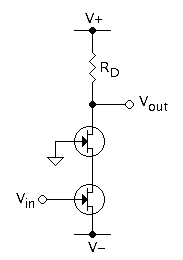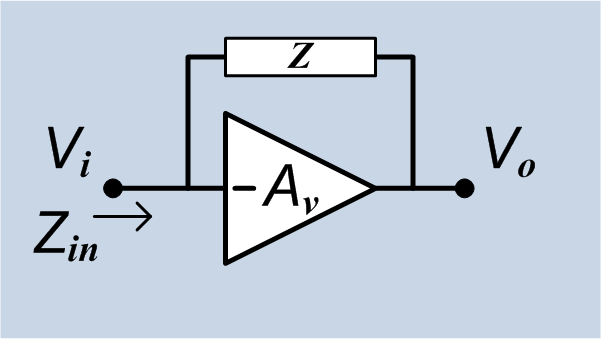|
Cascode
The cascode is a two-stage amplifier that consists of a common-emitter stage feeding into a common-base stage. Compared to a single amplifier stage, this combination may have one or more of the following characteristics: higher input–output isolation, higher input impedance, high output impedance, higher bandwidth. In modern circuits, the cascode is often constructed from two transistors (BJTs or FETs), with one operating as a common emitter or common source and the other as a common base or common gate. The cascode improves input–output isolation (reduces reverse transmission), as there is no direct coupling from the output to input. This eliminates the Miller effect and thus contributes to a much higher bandwidth. History The use of a cascode (sometimes verbified to ''cascoding'') is a common technique for improving analog circuit performance, applicable to both vacuum tubes and transistors. The name "cascode" was coined in an article written by Frederick Vinton Hunt an ... [...More Info...] [...Related Items...] OR: [Wikipedia] [Google] [Baidu] |
Common Source
In electronics, a common-source amplifier is one of three basic single-stage field-effect transistor (FET) amplifier topologies, typically used as a voltage or transconductance amplifier. The easiest way to tell if a FET is common source, common drain, or common gate is to examine where the signal enters and leaves. The remaining terminal is what is known as "common". In this example, the signal enters the gate, and exits the drain. The only terminal remaining is the source. This is a common-source FET circuit. The analogous bipolar junction transistor circuit may be viewed as a transconductance amplifier or as a voltage amplifier. (See classification of amplifiers). As a transconductance amplifier, the input voltage is seen as modulating the current going to the load. As a voltage amplifier, input voltage modulates the current flowing through the FET, changing the voltage across the output resistance according to Ohm's law. However, the FET device's output resistance typicall ... [...More Info...] [...Related Items...] OR: [Wikipedia] [Google] [Baidu] |
Common-base
In electronics, a common-base (also known as grounded-base) electronic amplifier, amplifier is one of three basic single-stage bipolar junction transistor (BJT) amplifier topologies, typically used as a current buffer or voltage amplifier. In this circuit the emitter terminal of the transistor serves as the input, the collector as the output, and the base is connected to ground, or "common", hence its name. The analogous field-effect transistor circuit is the common-gate amplifier. Applications This arrangement is not very common in low-frequency discrete circuits, where it is usually employed for amplifiers that require an unusually low input impedance, for example to act as a preamplifier for moving-coil microphones. However, it is popular in integrated circuits and in high-frequency amplifiers, for example for VHF and Ultra high frequency, UHF, because its input capacitance does not suffer from the Miller effect, which degrades the bandwidth of the common-emitter configurati ... [...More Info...] [...Related Items...] OR: [Wikipedia] [Google] [Baidu] |
Common-source
In electronics, a common-source amplifier is one of three basic single-stage field-effect transistor (FET) amplifier topologies, typically used as a voltage or transconductance amplifier. The easiest way to tell if a FET is common source, common drain, or common gate is to examine where the signal enters and leaves. The remaining terminal is what is known as "common". In this example, the signal enters the gate, and exits the drain. The only terminal remaining is the source. This is a common-source FET circuit. The analogous bipolar junction transistor circuit may be viewed as a transconductance amplifier or as a voltage amplifier. (See classification of amplifiers). As a transconductance amplifier, the input voltage is seen as modulating the current going to the load. As a voltage amplifier, input voltage modulates the current flowing through the FET, changing the voltage across the output resistance according to Ohm's law. However, the FET device's output resistance typicall ... [...More Info...] [...Related Items...] OR: [Wikipedia] [Google] [Baidu] |
Transistor
upright=1.4, gate (G), body (B), source (S) and drain (D) terminals. The gate is separated from the body by an insulating layer (pink). A transistor is a semiconductor device used to Electronic amplifier, amplify or electronic switch, switch electrical signals and electrical power, power. The transistor is one of the basic building blocks of modern electronics. It is composed of semiconductor material, usually with at least three terminals for connection to an electronic circuit. A voltage or current applied to one pair of the transistor's terminals controls the current through another pair of terminals. Because the controlled (output) power can be higher than the controlling (input) power, a transistor can amplify a signal. Some transistors are packaged individually, but many more are found embedded in integrated circuits. Austro-Hungarian physicist Julius Edgar Lilienfeld proposed the concept of a field-effect transistor in 1926, but it was not possible to actually constru ... [...More Info...] [...Related Items...] OR: [Wikipedia] [Google] [Baidu] |
Common-gate
In electronics, a common-gate amplifier is one of three basic single-stage field-effect transistor (FET) amplifier topologies, typically used as a current buffer or voltage amplifier. In this circuit, the source terminal of the transistor serves as the input, the drain is the output, and the gate is connected to ground, or "common," hence its name. The analogous bipolar junction transistor circuit is the common-base amplifier. Applications This configuration is used less often than the common source or source follower. It is useful in, for example, CMOS RF receivers, especially when operating near the frequency limitations of the FETs; it is desirable because of the ease of impedance matching and potentially has lower noise. Gray and Meyer provide a general reference for this circuit. Low-frequency characteristics At low frequencies and under small-signal conditions, the circuit in Figure 1 can be represented by that in Figure 2, where the hybrid-pi model for the MOSFET ... [...More Info...] [...Related Items...] OR: [Wikipedia] [Google] [Baidu] |
Common Base
In electronics, a common-base (also known as grounded-base) amplifier is one of three basic single-stage bipolar junction transistor (BJT) amplifier topologies, typically used as a current buffer or voltage amplifier. In this circuit the emitter terminal of the transistor serves as the input, the collector as the output, and the base is connected to ground, or "common", hence its name. The analogous field-effect transistor circuit is the common-gate amplifier. Applications This arrangement is not very common in low-frequency discrete circuits, where it is usually employed for amplifiers that require an unusually low input impedance, for example to act as a preamplifier for moving-coil microphones. However, it is popular in integrated circuits and in high-frequency amplifiers, for example for VHF and UHF, because its input capacitance does not suffer from the Miller effect, which degrades the bandwidth of the common-emitter configuration, and because of the relatively high is ... [...More Info...] [...Related Items...] OR: [Wikipedia] [Google] [Baidu] |
Common Gate
In electronics, a common-gate amplifier is one of three basic single-stage field-effect transistor (FET) amplifier topologies, typically used as a current buffer or voltage amplifier. In this circuit, the source terminal of the transistor serves as the input, the drain is the output, and the gate is connected to ground, or "common," hence its name. The analogous bipolar junction transistor circuit is the common-base amplifier. Applications This configuration is used less often than the common source or source follower. It is useful in, for example, CMOS RF receivers, especially when operating near the frequency limitations of the FETs; it is desirable because of the ease of impedance matching and potentially has lower noise. Gray and Meyer provide a general reference for this circuit. Low-frequency characteristics At low frequencies and under small-signal conditions, the circuit in Figure 1 can be represented by that in Figure 2, where the hybrid-pi model for the MOSFET ... [...More Info...] [...Related Items...] OR: [Wikipedia] [Google] [Baidu] |
Miller Effect
In electronics, the Miller effect accounts for the increase in the equivalent input capacitance of an inverting voltage amplifier due to amplification of the effect of capacitance between the input and output terminals. The virtually increased input capacitance due to the Miller effect is given by :C_=C (1+A_v)\, where -A_v is the voltage gain of the inverting amplifier (A_v positive) and C is the feedback capacitance. Although the term ''Miller effect'' normally refers to capacitance, any impedance connected between the input and another node exhibiting gain can modify the amplifier input impedance via this effect. These properties of the Miller effect are generalized in the Miller theorem. The Miller capacitance due to parasitic capacitance between the output and input of active devices like transistors and vacuum tubes is a major factor limiting their gain at high frequencies. Miller capacitance was identified in 1920 in triode vacuum tubes by John Milton Miller. History The ... [...More Info...] [...Related Items...] OR: [Wikipedia] [Google] [Baidu] |
Common-emitter
In electronics, a common-emitter amplifier is one of three basic single-stage bipolar-junction-transistor (BJT) amplifier topologies, typically used as a voltage amplifier. It offers high current gain (typically 200), medium input resistance and a high output resistance. The output of a common emitter amplifier is 180 degrees out of phase to the input signal. In this circuit the base terminal of the transistor serves as the input, the collector is the output, and the emitter is ''common'' to both (for example, it may be tied to ground reference or a power supply rail), hence its name. The analogous FET circuit is the common-source amplifier, and the analogous tube circuit is the common-cathode amplifier. Emitter degeneration Common-emitter amplifiers give the amplifier an inverted output and can have a very high gain that may vary widely from one transistor to the next. The gain is a strong function of both temperature and bias current, and so the actual gain is somewhat ... [...More Info...] [...Related Items...] OR: [Wikipedia] [Google] [Baidu] |
Field-effect Transistor
The field-effect transistor (FET) is a type of transistor that uses an electric field to control the flow of current in a semiconductor. FETs (JFETs or MOSFETs) are devices with three terminals: ''source'', ''gate'', and ''drain''. FETs control the flow of current by the application of a voltage to the gate, which in turn alters the conductivity between the drain and source. FETs are also known as unipolar transistors since they involve single-carrier-type operation. That is, FETs use either electrons (n-channel) or holes (p-channel) as charge carriers in their operation, but not both. Many different types of field effect transistors exist. Field effect transistors generally display very high input impedance at low frequencies. The most widely used field-effect transistor is the MOSFET (metal-oxide-semiconductor field-effect transistor). History The concept of a field-effect transistor (FET) was first patented by Austro-Hungarian physicist Julius Edgar Lilienfeld in 192 ... [...More Info...] [...Related Items...] OR: [Wikipedia] [Google] [Baidu] |
Common Emitter
In electronics, a common-emitter amplifier is one of three basic single-stage bipolar-junction-transistor (BJT) amplifier topologies, typically used as a voltage amplifier. It offers high current gain (typically 200), medium input resistance and a high output resistance. The output of a common emitter amplifier is 180 degrees out of phase to the input signal. In this circuit the base terminal of the transistor serves as the input, the collector is the output, and the emitter is ''common'' to both (for example, it may be tied to ground reference or a power supply rail), hence its name. The analogous FET circuit is the common-source amplifier, and the analogous tube circuit is the common-cathode amplifier. Emitter degeneration Common-emitter amplifiers give the amplifier an inverted output and can have a very high gain that may vary widely from one transistor to the next. The gain is a strong function of both temperature and bias current, and so the actual gain is somewhat ... [...More Info...] [...Related Items...] OR: [Wikipedia] [Google] [Baidu] |

.jpg)

